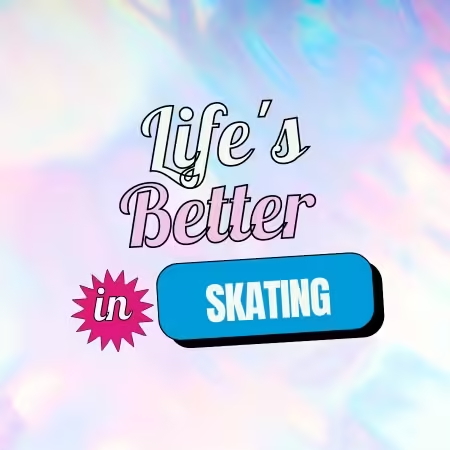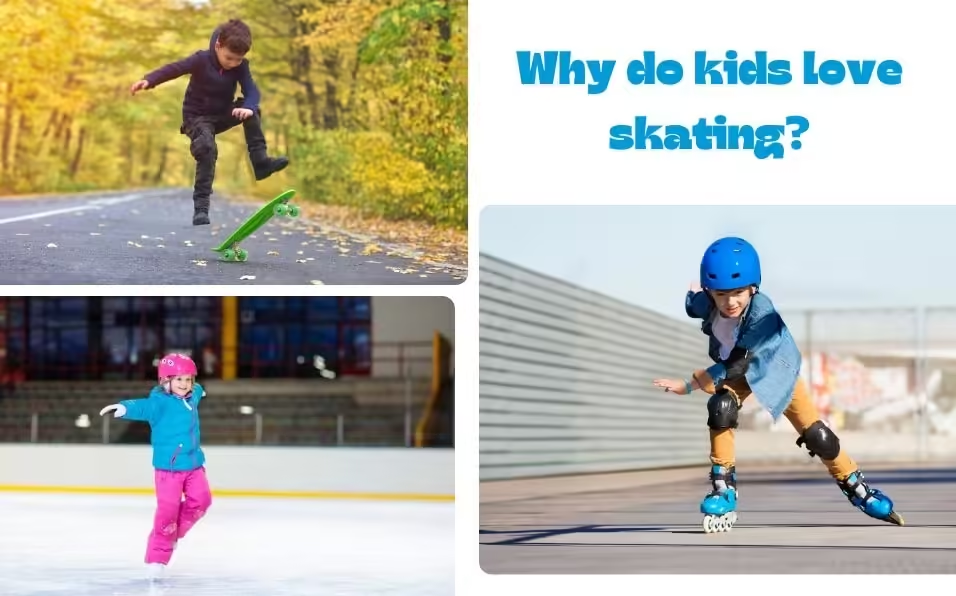Skating is exciting for people of all ages. Why do kids love skating? Favorite things for kids about skating:
Within this write-up
Why do Kids Love Skating?
1. Sense of Freedom
Skating makes kids feel free because it has the ability to move quickly and freely which is a fun experience.
2. An Enjoyable Experience
The feel of the skates gliding or rolling is great and it feels like they are flying, which can be awesome.
3. Physical Activity
Skating is a fun way for kids to exert some energy while getting active. Fitness on wheels.
4. Growth and Accomplishment
As children learn new skating skills or how to do a new trick, they receive the influx of dopamine from achievement, helping them gain confidence in further, more advanced tricks.

5. Social Aspect
Skating is often a social activity done in groups at parks or rinks. Join your kids to skate with friends or make new ones.
6. Variety of Styles
Kids Have Options in The Type of Skating: They do Roller skating, skateboarding and ice skating are all different ways of expressing similar basic movements.
7. Creative Expression
Skateboarding, playing sports or even engaging in figure skating helps kids express their creativity with tricks and moves that showcase a little bit about each kid’s personal style.
8. Accessible
Skating can be done almost anywhere (on the sidewalk, at the park, or in rink space) and is an easily accessible activity for kids to participate in.
9. Being a Part of Culture
For example, skateboarding is normally done in combination with music or fashion and belonging — this attracts children.
10. Exciting Gear and Equipment
11. Improvement through Practice
Skating allows for visible progress as kids improve their skills, which keeps them motivated and interested over time.
12. Parental Support
Skating encourages physical exercise, coordination and balance; thus, parents typically support it.
Benefits of Different Types of Skating and Riding for Kids
There’s something fun — and good for kids — about roller skating, skateboarding, scooter riding and ice skating. The activities develop strength, balance, and confidence. They also help to keep the heart healthy, and they make kids better at focusing. The kids can make friends and learn to work together. Every kind of exercise has its benefits towards a healthy, active lifestyle. Here’s how each of these exciting activities help kids grow in amazing ways.
1. Physical Health
These activities are great for developing balance, coordination and muscle for kids. In Roller skating, and ice skating, you use your entire body. They specially make your legs and core stronger. These activities also help your heart and lungs. They keep kids active and healthy.
2. Mental Health
Engaging in physical activity like skating promotes focus and concentration. Kids need to focus on their movements. This helps them think better. These activities also help them feel less stressed. They can feel happy and calm. As kids learn new skills or tricks, they feel proud. This makes them more confident.
3. Social Interaction
Skating is generally conducted with friends or in groups. You skate in places, like skate parks or rinks. These spots help people talk and have fun together. Children improve teamwork and communication — and have fun with friends. They also have chances to try to make new friends and connect over similar life experiences.
4. Cognitive Development
Skating helps kids to think better and solve problems. They pick the best route when on a skateboard. On a scooter, they make quick decisions. These activities help kids understand space and improve their thinking.
5. Creative and Fun
They can also be creative. Skateboarding or roller-skating tricks let kids express themselves. Kids can also design their own gear or a signature style of skating. Most of all, skating is fun, which not only gets your kids moving, but can lead to a lifetime of fitness.
6. Risk Management
Skating is a great opportunity for kids to learn about risk management and fear. In the end, kids get braver. They might ride down a hill in their first lesson. Or they might try a new trick at the park. Sometimes, things go wrong. But each time, they learn. They grow strong and don’t give up. Skating also enforces the rules of safety, explaining why helmets and pads are necessary to avoid injuries.
What are Basic Skating Skills?

Children should learn the basic skating skills to skate safely. The basic skating skills are as follows:
1. Balancing
The first things to learn in skating is balancing. Children need to learn this foundational skill for all types of skating that involves maintaining steady body posture while standing or moving.
2. Starting and Stopping
Parents should show their kids how to push off and glide forward. And show how to safely come to a controlled stop. This often includes techniques like the T-stop in ice skating or foot brake in roller skating.
3. Proper Stance
Children should keep their knees slightly bent and body centered to maintain stability while skating, which prevents falls.
4. Pushing
Kids should use one foot to push off the ground or ice while the other glides, it helps to propel the skater forward.
5. Turning
Kids should learn shifting body weight to make smooth turns, such as crossovers or basic pivots. For skateboarding, it involves leaning the body to direct the board.
6. Gliding
After pushing, kids should learn how to maintain momentum and glide smoothly without constantly needing to push.
7. Falling Safely
To reduce injury, kids need to learn to fall correctly, with knees bent and body rolled. Many skating beginners practice falling to minimize the impact of future falls.
8. Stopping Techniques
Children should learn different stopping methods depends on types of skating. Snowplow stop is a stopping technique in ice skating and toe stop or drag stop is a stopping technique in roller skating. In skateboarding, rubbing the foot on the surface or carving helps reduce speed. In scootering, it’s most common to use the rear foot brake or drag the foot.
9. Speed Control
Children should learn to regulate speed through proper footwork and balance. They also need to learn to slow down and accelerate as needed.
10. Backward Skating
Kids need to learn how to push and glide in reverse while maintaining control.
11. Crossovers
Kids should learn the technique for making sharp turns or increasing speed by crossing one foot over the other during a turn, commonly used in ice skating and roller skating.
12. Foot Positioning
Kids should learn how to position the feet in different situations. Heels together for stops, V-shaped stance for forward gliding.
13. Edge Control
In ice Skating on ice, kids should understand how to use the inner and outer edges of the skate blades for more efficient movement and control.
14. Pump and Carve Skateboarding
Children should learn “pumping” to sustain speed, and “carving” to turn smoothly in skateboarding, both are crucial for fluid riding.
15. Movement Transitions
Kids also need to learn to move smoothly from gliding to turning or forward to backward skating.
The above techniques are the foundation for advanced skating skills. Children can become experts in skating with consistent practice and endurance. Regular skating practice contributes to the good health of kids.
Affiliate Disclaimer: kidsallitems.com is a participant in the Amazon Associate Program, which means we will earn a small commission if any customer makes any purchase through our Amazon Affiliate Links, with no additional cost to the customer. As an Amazon Associate, our website earns from qualifying purchases.
Price information on this website is current but subject to change. We keep the information current, but Amazon prices, availability, and other details may fluctuate. For current pricing and information, please check the Amazon product page provided at the affiliate link.



